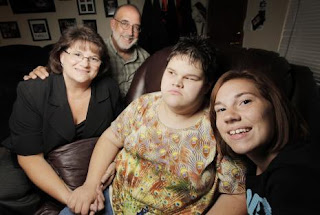
From Houston Public Radio,
KUHF, by health, science and technology reporter Carrie Feibel:
Kathleen DeSilva (pictured) and her husband live in a small bungalow in the Heights – and they relish every freedom that comes with it.
“You can’t have pets in a nursing home, and we love to have our dogs. We’ve had dogs for years now.”
DeSilva cannot breathe without a ventilator. She has been paralyzed from the neck down since a high school gymnastics accident 42 years ago. Her husband Peter Simmons broke his neck in a motorcycle crash when he was 28. While many people with disabilities must live in a nursing home, this couple has fought for decades to live on their own terms.
“We did have to renovate the bathroom to make it wheelchair accessible, we had to add ramps front and back. And we built a garage at the back of our house that has apartments in it, and in those apartments is where our caregivers live.”
It helps that DeSilva worked for 22 years as an attorney for Memorial Hermann Hospital. She’s retired now, and the couple budgets carefully so they can pay their three caregivers. Peter Simmons enjoys photography, and he leads the dogs on daily wheelchair walks. Kathleen DeSilva directs the cooking, instructing the caregiver exactly how to prepare and spice the food.
“A big part of independent living is that you direct your own care. And you tell people what to do for you, in the way that you want it done. So that they don’t come in with preconceived notions about how your care should be done.”
Other people with disabilities are less fortunate. The Texas government has identified tens of thousands of people who live in nursing homes — but have expressed a wish to get out. They are waiting for special waivers that would allow them to spend their Medicaid money outside of the nursing home. For example, if they could apply the money to visiting nurses or adaptive equipment, they could live independently.
“I mean, I don’t know anybody who would voluntarily move into a nursing home.”
Lex Frieden directs an independent living research program affiliated with Memorial Hermann.
“The only reason people have to move into nursing homes now, by and large, is that they don’t have access to assistance in the community.”
In 1999, the U.S. Supreme Court weighed in. It ruled that people with disabilities have a right to live in the least restrictive setting possible. State governments scrambled to comply. Texas has at least eight different programs to promote independent living, but it can’t keep up with all the demand.
“I would love to move everyone out of a nursing home if that were feasible.”
That’s Aileen McCormick, the regional CEO for Amerigroup, a managed-care company. Amerigroup has a contract with Texas to – in McCormick’s words — “liberate” patients from nursing homes. Since 2007, Amerigroup has moved almost 400 people out of nursing homes, and prevented close to a thousand people from having to move into one.
“The stories we get from folks who feel like they’ve been given their life back and the beauty for taxpayers in Texas is, it’s a less costly option.”
State officials say they are still gathering data on exactly how much money is saved, per person. It’s difficult because every medical case is unique. But they agree that at-home care is cheaper, on average, than nursing homes.
“It really is true and it works. And so I think there is a real movement that says ‘Hey if this is good for Texans in all of these urban markets, why is it not good for Texans in other markets where we don’t do it yet?’”
This type of program is not yet available statewide. Amerigroup plans to lobby the Texas Legislature for permission to expand into the Rio Grande Valley and elsewhere.
 From the Snowmass Sun:
From the Snowmass Sun:










